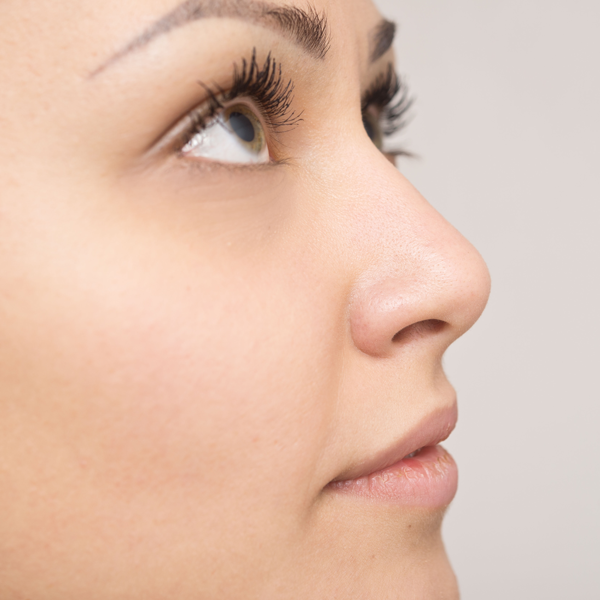
Rhinoplasty, commonly known as a nose job, is a cosmetic surgery for male and female patients that changes the appearance of the nose. Board-certified plastic and cosmetic surgeon, Dr. Paul Critelli, offers this procedure to his patients to provide a beautiful, subtle, natural outcome. The procedure is performed to correct a nasal dysfunction (such as a deviated septum), or cosmetically improve the appearance of the nose per the patient’s aesthetic goals. Some rhinoplasty surgeries are reconstructive in nature, which is the case for patients who have experienced trauma. The most common reason to have rhinoplasty is for cosmetic purposes.
There are many reasons a person might want a rhinoplasty procedure, otherwise known as a “nose job.” Rhinoplasty improves the shape of the nose and enhances facial balance. This also can be done to correct difficulty breathing by aligning the nasal structure to improve breathing.
Using advanced techniques, Dr. Critelli can help patients achieve the look they’ve always desired and give patients the ability to breathe easily again.
About the Surgery
There are several techniques used for rhinoplasty. The approach taken will be based on the complexity of the surgical case and the overall goal of the patient.
Open Rhinoplasty
With an open rhinoplasty, the incisions are made on the tissue between the nostrils or on the natural crease of the nose just above the lips. This allows for greater access and view of the confines of the nose. Surgeons prefer this as it is easier to manipulate the bones and cartilage. The skin is peeled back to reveal the internal structure of the nose and redraped once reshaping is completed. The scars associated with this approach are tiny - less than 5mm - so they are not easily noticeable once fully healed.
Closed Rhinoplasty
During a closed rhinoplasty surgery, incisions are made to the inside of the nose through the nostrils. This is a common technique for patients who desire mild reshaping. This approach does not cause visible scarring. For severe reshaping cases, the open technique will be implemented.
Non-Invasive Rhinoplasty
For minor reshaping, some patients may opt to try an injectable filler to achieve results. These come in a variety of liquid substances, and sometimes a fat transfer can also be utilized. A filler can help add volume to hide small deformities, such as a bump or a bony appearance. It is important to note that fillers can only do so much in the reshaping process. For most patients, surgery is a better option and will offer a permanent solution.
During/After Surgery
Rhinoplasty is performed at UT Health Tyler under general anesthesia. The procedure lasts up to 2 hours and is considered outpatient. After surgery, there will be swelling and soreness around the nose area. Bruising is also a side effect of surgery. The nose will be placed in a splint for additional support. During the first 7-10 days following surgery, the side effects will begin to disappear and the splint will be removed. Patients will be able to see their results immediately; however, it may take several months for the full results to appear.
Expected Cost
Schedule an appointment for a customized consultation with Dr. Critelli to determine the cost of your procedure. For more complex cases, skin or fat grafting, or even cartilage reconstruction may be performed. If the procedure is purely cosmetic, the expenses are the patient’s responsibility. However, if reconstruction is performed to correct a deformity, trauma or medical condition, insurance may cover a portion of the expense.
FAQs
Is it risky?
All surgical procedures carry some form of risk. These risks can be greatly minimized if an experienced nose surgeon is chosen to perform the surgery. While rhinoplasty is one of the most commonly performed procedures in the U.S., surgeon skill is critical so that a beautiful, satisfactory outcome can result.
Broken nose?
Around half of all rhinoplasty cases will include some form of nose breaking in order to allow the surgeon to reshape the cartilage and bone. This is primarily intended for patients who have nasal asymmetry. The broken bone or cartilage will be reshaped and reattached, and then supported by splints during recovery.
What is a nasal pack?
Nasal packing is done to help with bleeding, especially if the surgery involves the septum. Gauze or cotton packs are inserted into the nasal chamber during this process. Patients find it uncomfortable, but the packing is only in for a short-term during the immediate recovery phase.
Surgical or nonsurgical?
This depends on the patient’s nose structure and what aesthetic result is trying to be achieved. For significant reshaping, the surgical approach will be performed as this allows the surgeon to manipulate the cartridges and bones. If the patient is looking for a subtle improvement, adding volume to the area may suffice.
